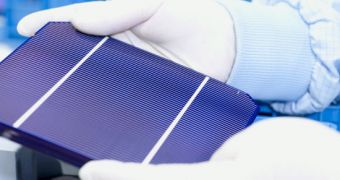Officials at the Boeing Company announce that the corporation has begun to mass-produce the C3MJ+, which is the newest type of terrestrial solar cell developed by the wholly-owned subsidiary Spectrolab.
The cells have a conversion efficiency of 39.2 percent, meaning that they convert more than a third of the total amount of sunlight hitting them into usable electricity. This makes it the industry’s highest-efficiency cell, the company says.
The new devices represent an improvement from the former variant, called C3MJ, which had a conversion efficiency level of 38.5 percent. The additional increase in efficiency is due to the company's experience in the field.
Sylmar, California-based Spectrolab Inc. has recently reached an important milestone in its 50-year history, when it produced its 3 millionths multi-junction, space-based solar cell.
The marker was reached after 15 years of being in this business, and represents an indicator of the boom the satellite industry has been experiencing over these past years.
But the new concentrator photovoltaic (CPV) cells are not meant for powering up spacecrafts, landers or rovers, but for obtaining renewable energy from the Sun here on Earth.
“These more efficient cells are drawing interest from a number of current and potential customers. Last year we set a new world record for efficiency with a test cell that peaked at 41.6 percent,” says Russ Jones.
“We now have entered production with essentially this same technology and plan to deliver the first of these 39.2 percent efficiency cells in January,” adds the official, who is the Spectrolab director of CPV Business Development.
He explains that the company has been in the habit of introducing new generations of solar cells in production each year since 2007. Each year, the cells have increased energy-conversion efficiency, the official goes on to say.
Since mid-2009, Spectrolab has sold more than 2 million C3MJ cells, but Jones believe that the customers who have already purchased these devices once will do so again in the future.
“Given the new cells' close similarity to our existing production cells, we believe that our current C3MJ customers will be able to easily upgrade for more efficiency,” he explains.
The company has been in business since 1956, and one of its products was installed on the Moon during the Apollo 11 mission, back in 1969.
Both Mars Exploration Rovers feature panels built by Spectrolab, as does a NASA orbiter around the Red Planet. Its solar cells will also go on the future NASA Juno mission to Jupiter.
All panels on the International Space Station (ISS) come from the company too, and about 60 percent of all satellites in orbit can harness sunlight due to the engineering expertise at Boeing.
“Many years of continuous improvement in product design and high-volume manufacturing experience have allowed Spectrolab to develop mature, cost-effective and repeatable processes, resulting in the delivery of high-quality, reliable and affordable products to both space and terrestrial customers,” says David Lillington. the president of Spectrolab.

 14 DAY TRIAL //
14 DAY TRIAL //